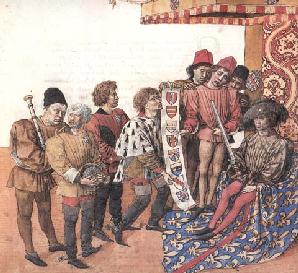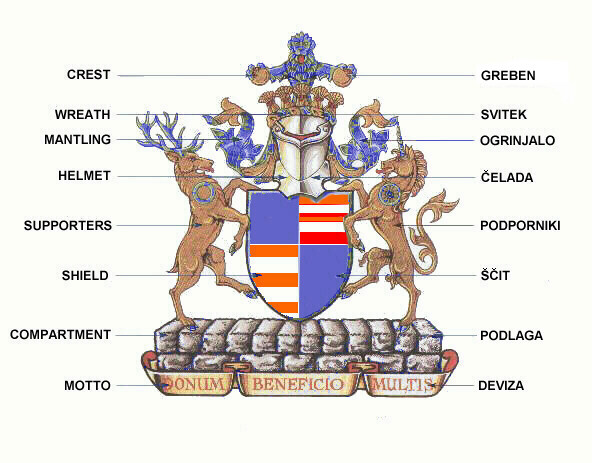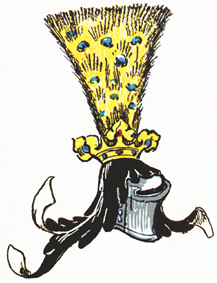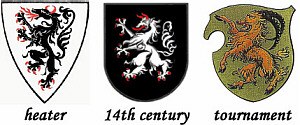
 |
| (Pognon, Edmond M, trans. Le Livre des Tournois du Roi Rene, c1460. Paris: Editions Hercher, 1986. P24.) The King of Arms of the Duke of Brittany presents a roll painted with the arms of those proposed to judges of a tournament to the Duke of Bourbon. |
Heraldry, strictly speaking, embraces all the duties of a herald, although the modern connotation of the word heraldry encompasses the study, design, regulation and use of armorial bearings. Armorial bearings are commonly known as "coats of arms". During the Medieval period, heralds were employed as staff officers in war who were directly responsible to the constable or commander-in-chief and the marshal, as well as being employed by households of European kings and greater barons. In times of peace, they announced and organized tournaments. Their duties included the administration and archiving of personal devices and cognisances of nobility and gentry, now one of the principal activities of the English and Scottish heralds. Due to the free movement of knights between different countries and participating in tournaments, it became the responsibility of the heralds to ensure that no two knights possessed the same coat of arms. It can be said that the imagination and development of later medieval armory (armorial bearings) and its flamboyant growth in the 16th century can be traced back to these heralds.
Unfortunately, there is little information at this time regarding heralds, or even if they in fact existed in Slovenia in the centuries past. It is unknown if the knights, dukes and other warrior-type of nobility travelled the lands to participate in medieval tournaments, however, there is evidence in chronicles recording the existence of medieval tournaments were held in Slovenia, including a jousting match between Ulrich von Liechtenstein (ca. 1200-1275) against Otto von Buchs, the Lord of the Manor in Murica (Mürz) Valley, the rules based on chivalric customs. Further research in this area is necessary to more fully expand on the traditions of heraldry specifically as it pertains to Slovenia, and as this area of research evolves, new information will be inserted into this website when it becomes available. Click on the "history of heraldry" for a brief on the development and history of heraldry in general as well as in Slovenia.
The Heraldic Achievement
Assuming that Janez Vajkard Valvasor (1641-1693) doesn't mind, we are using his armorial achievement as an example to highlight the various elements. The motto scroll positioned below the arms is an additional element purely for instructional purposes as his original achievement does not possess a scroll.

The Crest
Frequently, the term "crest" is misused to refer to the entire heraldic achievement of an individual. In fact, it only refers to the element on top of the helm or helmet. In the early days of heraldry, these were quite simple in design, but later evolved into fantastical creations worn on the helmets of combatants competing in medieval tournaments. This was reflected in the crest  design of heraldic achievements. In the case of Valvasor's arms, the crest is composed of the black eagle with wings spread "eagle Sable displayed" positioned on a gold coronet or "coronet Or". In Carantanian history, the crest of Leopold VI of Babenberg (+ 1230) was composed of peacock feathers, making its appearance in later years on the seal of Ulric III of Carinthia.
design of heraldic achievements. In the case of Valvasor's arms, the crest is composed of the black eagle with wings spread "eagle Sable displayed" positioned on a gold coronet or "coronet Or". In Carantanian history, the crest of Leopold VI of Babenberg (+ 1230) was composed of peacock feathers, making its appearance in later years on the seal of Ulric III of Carinthia.
The Helmet, Mantle and Wreath/Coronet
Heraldry has its roots in tournament and battle, and therefore, the warriors of the period wore helmets as defensive elements both in tournaments and battle. The most common helmet included in a heraldic achievement was the classic tournament helm, sometimes called the "frog helm" due to the occulara being only a narrow slit across the fron of the helm, with a large facial and chin plate giving the appearance of a "frog's head". Other helms in use were one's sporting a barred visor, where the bars were vertical and if facing directly towards the viewer, these helms typically represented a helmet of royalty.
The helms were frequently fitted with a wreath or "torse" which was composed of colorful silk twisted into a circular shape and placed on the helm, most likely to help conceal the unsightly join between the crest and helmet.
Attached to the helm is the mantling, which originated as a cloth worn by the knight warrior draped down over the shoulders to help shade the individual from the heat of the sun while wearing armour. The mantling is typically illustrated as being attached to the wreath or "torse". Heraldic artists now show the mantling as a highly stylized fashion adding to the impressiveness of the achievement.
The Motto
Most coats of arms will display a motto, written on a scroll usually below the achievement, sometimes above. The motto was frequently written in Latin, but other classical languages were used as well. In most cases, the motto is a brief phrase expressing some moral, loyal or even pious ideal. In some cases, the achievement may have two mottos, one above and one below the arms. The motto depicted above with Valvasor's achievement was added for instructional purposes only.
The Shield or Arms
 History reveals that original heraldry appeared as designs painted on shields and today, remains the central focus of the heraldic achievement. It is possible to have an achievement without a crest, motto or mantling, but a shield always forms the achievement. The shields comes in a variety of shapes, such as the "heater" sheild, XVth century shield, renaissance shield (similar to Valvasor's shield) and sometimes, a tournament shield which has a notch in it which served as a lance rest in tournaments and times of war.
History reveals that original heraldry appeared as designs painted on shields and today, remains the central focus of the heraldic achievement. It is possible to have an achievement without a crest, motto or mantling, but a shield always forms the achievement. The shields comes in a variety of shapes, such as the "heater" sheild, XVth century shield, renaissance shield (similar to Valvasor's shield) and sometimes, a tournament shield which has a notch in it which served as a lance rest in tournaments and times of war.
Supporters and Compartment
Not shown in the above heraldic achievement, sometime in the late 14th and mid 15th centuries, the nobility began to employ a new element on their arms known as "supporters". These were usually in the form of an animal or human figures, and sometimes fantastical beasts, standing beside the shield, with an arm, leg or wing in contact with the shield giving the appearance of it supporting the shield. As the heraldic achievement evolved, the appearance of a "compartment", which often appeared as a grassy knoll or mound on which the supporters would stand on. Sometimes, the compartment was composed of excess mantling providing a foundation for the supporters to rest on. The design of the compartment was entirely up to the creative liberties of the heraldic artist.